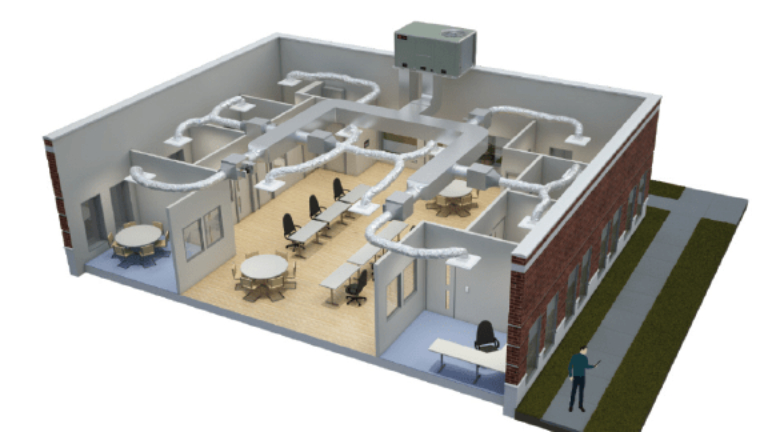Blog
Published: February 18, 2022
The Evolution of Changeover Systems
Many light commercial buildings use single-zone rooftop units with thermostats. For zoning, a changeover bypass system was used, but it led to higher energy use and noise.

Quick Facts
- Products
- Zoned Rooftop Systems • Zoned Rooftop Systems

Many light commercial buildings have traditionally used several single-zone, packaged rooftop units with thermostats—often because better systems were thought to be too complicated and/or too expensive to install. If “zoning” was desired in these buildings, a changeover bypass system was traditionally used; this system allowed a single rooftop unit to provide independent temperature control to several zones. However, it used a constant-speed supply fan and a centralized bypass damper, resulting in higher energy use and sound levels than other system alternatives.

The latest generation of the multiple-zone, changeover system is the changeover VAV system. This system makes use of efficient, variable-speed technology to reduce HVAC energy use—by as much as 50 percent compared to constant-volume systems (see example energy comparisons in the Trane Zoned Rooftop Systems catalog).
The changeover VAV system
A changeover VAV system is comprised of a single rooftop unit serving two or more VAV terminal units (see below). As the loads in the zones change, the dampers in the VAV terminal units modulate the airflow delivered to each zone. The rooftop unit’s supply fan responds by varying its speed to provide a variable volume of conditioned air, maintain the duct static pressure at the setpoint while cooling or heating capacity is staged or modulated to maintain the supply-air temperature at the setpoint.
Fixed- or variable-speed scroll compressors provide cooling, while heating is provided by a gas or electric heater (or, in some cases, a hot-water coil) or by reversing the refrigeration system to operate as a heat pump.

The Tracer Concierge system control panel uses a voting strategy to determine whether the rooftop unit should provide cooling or “changeover” to heating mode. Each VAV terminal unit “votes” toward the overall system mode—heating or cooling—based on the difference between the current zone temperature and its active setpoint. In addition, the Concierge™ system control panel monitors the cooling and heating demands of each zone and dynamically resets the rooftop unit’s supply-air temperature setpoint to maximize overall comfort.
Choice of heat in the rooftop unit
If the rooftop unit is a heat pump or equipped with a staged heater, the supply fan will operate at full speed when in heating mode. This requires a bypass damper to be installed between the supply and return ductwork, to allow excess supply airflow to recirculate to the rooftop unit (in heating mode only).
If the rooftop unit is equipped with a modulating heater, the supply fan varies airflow when in heating mode. In many cases, this avoids the need to install a bypass damper. However, a bypass damper may be required if the system airflow in heating mode is expected to drop below the minimum threshold required for the modulating heater.
Selection of a modulating heat source in the rooftop unit (modulating gas burner, hot-water coil, or SCR electric heater) is recommended for a changeover VAV system that is expected to operate for a significant number of hours in heating mode. Comfort will likely be improved due to more-stable control of the supply-air temperature. This will also reduce (and maybe avoid) the need to bypass excess airflow, thus reducing fan energy use.
Adding heat in the VAV terminal units?
In a changeover VAV system, a VAV terminal unit serves each zone, with a zone temperature sensor connected to it.
When the rooftop unit is operating in heating mode (left-hand chart below), it delivers warm air to all the VAV terminal units. If the zone requires heating (VAV Heat/Cool Status = HEAT), the VAV damper modulates airflow between its maximum and minimum heating airflow setpoints, as required to maintain zone temperature at its heating setpoint. If the zone requires cooling (VAV Heat/Cool Status = COOL), the VAV damper closes to its minimum heating airflow setpoint and the controller begins to “vote” for the rooftop unit to switch to cooling mode.
When the rooftop unit is operating in cooling mode (right-hand chart below), it delivers cool air to all the VAV terminal units. If the zone requires cooling (VAV Heat/Cool Status = COOL), the VAV damper modulates airflow between its maximum and minimum airflow setpoints, as required to maintain zone temperature at its cooling setpoint. If the zone requires heating (VAV Heat/Cool Status = HEAT), the VAV damper closes to its minimum airflow setpoint and the controller begins to “vote” for the rooftop unit to switch to heating mode.

To improve occupant comfort, consider equipping some of the VAV terminal units with a small electric heater or hot-water coil. When the rooftop unit is operating in cooling mode, this allows some amount of heat to be provided to a zone that may require heating (e.g., entryways, lobbies, conference rooms). In this case, the local heater need only be sized to provide sufficient capacity during mild or cool weather, not sized for full heating capacity during the coldest weather. During very cold weather, the rooftop unit will changeover to operate in heating mode.
If a VAV terminal unit is equipped with a local heater, its control sequence is unchanged when the rooftop unit is operating in heating mode; the local heater is disabled. However, when the rooftop unit is operating in cooling mode and delivering cool air to all the VAV terminal units, the VAV terminal unit will activate the local heater to prevent the zone from over-cooling. The controller will not “vote” for the rooftop unit to switch to heating mode unless the local heater is no longer able to maintain zone temperature at its setpoint.
Trane Zoned Rooftop Systems
Trane Zoned Rooftop Systems combine packaged rooftop units, VAV terminal units, a Tracer Concierge control system, and Air-Fi Wireless controls into pre-engineered systems that provide light commercial customers with cost-effective options to increase comfort and energy efficiency while simplifying operation and maintenance.
They are available in single- or multiple-zone configurations, including the changeover VAV system described in this post. For more information, application considerations, and example specifications, see the Trane Zoned Rooftop Systems catalog.
